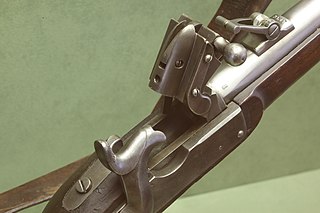 W
WThe 1792 contract rifle is not a specific model of gun, rather it is a modern way to categorize a collection of rifles bought by the United States government in that year. United States 1792 contract rifles are Pennsylvania-Kentucky Rifles with a 42-inch octagon barrel in .49 caliber, with a patch box built into the buttstock. What distinguishes them from civilian rifles is that they were bought by the government under military contract.
 W
WThe carabine à tige was a type of black-powder, muzzle-loading rifle invented by Louis-Etienne de Thouvenin. The method was an improvement of the invention of another Frenchman, Henri-Gustave Delvigne. Delvigne had developed chambered carbines and rampart rifle-muskets so that when forced against the chamber rim by ramming, the bullet would become deformed and flatten, so as to expand in diameter against the inside of the bore, allowing the bullet to press against the rifling grooves. When fired, the bullet accompanied the rifling and spun. This was an early attempt to work around one of the greatest hindrances to the use of military rifles; in order for a rifle to impart the proper spin to a projectile, the projectile must fit snugly inside the barrel to engage the rifling grooves. The problem, however, was that the black powder used at that time would quickly produce a thick layer residue of fouling. After only three or four shots, a typical rifle would be impossible to reload without using a mallet to force the bullet down the fouled barrel. Delvigne's design addressed this problem by introducing a projectile that was smaller than the bore of the barrel which after loading could then be struck with a ramrod. With three strokes of the ramrod, the bullet would become deformed and flatten, so as to expand in diameter against the inside of the bore, allowing the bullet to press against the rifling grooves. When fired, the bullet would accompany the rifling and spin. This improvement preserved accuracy while reducing the time required for reloading which would otherwise have been necessitated by the heavy fouling.
 W
WThe Hawken rifle is a muzzle-loading rifle built by the Hawken brothers that was used on the prairies and in the Rocky Mountains of the United States during the early frontier days. It has become synonymous with the "plains rifle", the buffalo gun, and the fur trapper's gun. Developed in the 1820s, it was eventually displaced by breechloaders and lever-action rifles which flourished after the Civil War.
 W
WThe Infanteriegewehr Modell 1842 was one of the first standardised service rifles used by the Swiss armed forces. It was introduced in 1842 as a result of a decision by the authorities of the Old Swiss Confederacy to standardise the weapons of the then still separate armies of the Swiss Cantons.
 W
WThe long rifle, also known as longrifle, Kentucky rifle, Pennsylvania rifle, or American longrifle, was one of the first commonly used rifles for hunting and warfare. It is characterized by an unusually long barrel, a development in American rifles that was uncommon in European rifles of the same period.
 W
WThe M1841 Mississippi rifle is a muzzle-loading percussion rifle used in the Mexican–American War and the American Civil War.
 W
WThe U.S. M1814 rifle was designed by Robert T. Wickham. The manufacturing was contracted out to Henry Deringer and R. Johnson to make rifles for use by the military.
 W
WThe M1817 common rifle was a flintlock muzzle-loaded weapon issued due to the Dept. of Ordnance's order of 1814, produced by Henry Deringer and used from the 1820s to 1840s at the American frontier. Unlike the half octagon barreled M1814 common rifle that preceded it, it had a barrel that was round for most of its length. The 36-inch barrel was rifled for .54 caliber bullets. For rifling it had seven grooves. Like the M1814 common rifle, it had a large oval patch box in the stock, however the stock dropped steeper than on the M1814 common rifle.
 W
WA musket is a muzzle-loaded long gun that appeared as a smoothbore weapon in the early 16th century, at first as a heavier variant of the arquebus, capable of penetrating heavy armor. By the mid-16th century, this type of musket went out of use as heavy armor declined, but the term musket continued as the name given for any hand held long gun until the mid-19th century. This style of musket was retired in the 19th century when rifled muskets became common as a result of cartridged breech-loading firearms introduced by Casimir Lefaucheux in 1835, the invention of the Minié ball by Claude-Étienne Minié in 1849, and the first reliable repeating rifle produced by Volcanic Repeating Arms in 1854. By the time that repeating rifles became common, they were known as simply "rifles", ending the era of the musket.